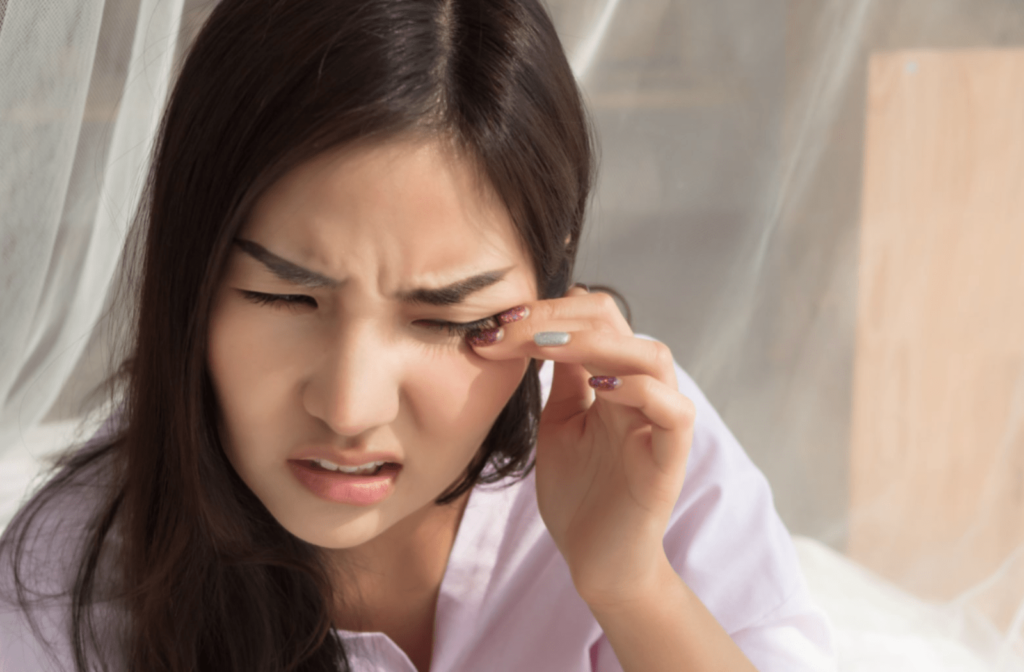You may have never heard of meibomian gland dysfunction (MGD), but if you’ve suffered from dry, watery, or irritated eyes, you may have experienced it. MGD is the most common cause of dry eye disease that affects the eyes’ oil glands.
Meibomian gland dysfunction refers to when your meibomian glands become blocked or inflamed and restricts the flow of meibum oil, which normally keeps your tears from evaporating. Your optometrist can examine your tear health and recommend personalised treatments to unclog your meibomian glands.
What Are the Meibomian Glands?
The meibomian glands are tiny oil-producing glands located in the eyelids. Each eyelid has approximately 25 to 40 meibomian glands. They secrete an oil called meibum, which forms the outermost layer of the tear film. Your tear film consists of 3 layers:
- The innermost mucus layer, which fastens tears to the eyes
- The middle aqueous layer, which nourishes the eyes with moisture and proteins
- The oily outermost layer, where meibum helps prevent tear evaporation from the eye’s surface.
When the meibomian glands become clogged, inflamed, or dysfunctional, they may not produce enough meibum, leading to what experts refer to as “poor-quality” tears. This is meibomian gland dysfunction, the cause of 85% of recorded dry eye cases!
Risk Factors for MGD
While anyone can develop MGD, certain factors can increase your risk, including:
- Age: People make fewer tears as they age.
- Sex: Women are more likely to develop dry eyes, such as during pregnancy.
- Medications: Antihistamines, decongestants, antidepressants, and other medicines can sometimes reduce tear health.
- Environment: Hot, dry, or windy locals can cause your tears to evaporate too fast.
- Medical conditions: Certain conditions like Sjögren’s syndrome, rheumatoid arthritis, and lupus can reduce tear production.
- Skin and eyelid disorders: Inflammation around the eyes can increase the risk of meibomian glands clogging.
- Excessive amounts of screen time: Working for long periods on digital screens can make you blink less and dry your tear film.
MGD Symptoms
MGD symptoms, or dry eye symptoms in general, can be quite a bother. They sneak up on you throughout the day and just don’t seem to let go. Here are some symptoms you should be on the lookout for:
- Stinging, burning, or scratchiness
- Blurry vision
- Red eyes
- Light sensitivity
- Stringy mucus around the eyes
- Damage to the front of the eye
- Watery eyes (Your body may produce too many tears, which all evaporate too fast)
These symptoms can vary from person to person, and they might come and go. But, if you’re experiencing any of these, give your optometrist a call. We can examine your tears and determine if MGD is the cause.
Treatments for MGD
Effective eye care means taking care of you like family, which requires finding personalised solutions tailored to your needs. While there isn’t a single cure-all for dry eye disease, we’ve got a whole list of treatments ready to tackle that pesky meibomian gland dysfunction head-on.
Prescription Eye Drops
Moisturising eye drops are often the first line of defense against dry eye symptoms. These drops can help lubricate the eyes and reduce inflammation, providing much-needed relief. Some prescriptive eye drops are specifically designed to treat chronic dry eye by reducing inflammation and helping to restore the natural tear film.
Some people may require anti-inflammatory steroid eye drops as well. Although, some of these treatments may take several weeks of use before providing noticeable relief.
Medications
In some cases, oral antibiotics or anti-inflammatory medications can help improve meibomian gland dysfunction. These medications can help reduce inflammation in and around the glands, allowing oil production to return to normal levels.
Some studies have also shown that omega-3 supplements can help increase tear oil content, providing relief from chronic dry eye.
Punctal Plugs
Punctal plugs are small, biocompatible devices inserted into the tear ducts to help prevent tears from draining too quickly. By keeping the eyes hydrated for longer periods, punctal plugs can help relieve dry eye symptoms.
You can use them with or without other treatments we’ve mentioned. Depending on the severity of MGD, a specialist may recommend temporary or semi-permanent plugs
iLux Treatments
The iLux treatment is a novel and effective procedure that uses a handheld device to warm meibomian glands and unclog blockages. The treatment can be performed directly in the office and takes about 10 minutes during which you can lay back and relax.
The iLux warms up to a precise temperature, which helps to soften the oils and decongest the glands. Once the glands are clear, your optometrist may manually massage them to help gently express the meibum oils. The results of iLux therapy are often immediate, though symptoms can continue to improve over the coming weeks.
Dry Eye Relief for Grande Prairie
Dry eyes can be a challenging condition to live with, but with the right treatment plan, we can reduce symptoms significantly. Our experienced team at Doctors EyeCare Grande Prairie can help determine which combination of treatments is right for you. At the end of the day, our goal is to manage the underlying cause of dry eyes and improve your overall eye health.
We provide personalised care and tailored solutions to all our patients, including those with MGD. Book an appointment today if you’re experiencing any dry eye symptoms, and let us help you feel the relief of comfortable vision!




